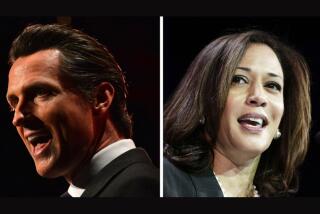L.A. in contract talks to keep E3 convention in city
- Share via
The largest annual convention in Los Angeles — a video games conference that wraps up Thursday — may be in play.
Los Angeles city officials are in negotiations with organizers of the Electronic Entertainment Expo, or E3, to ensure that the vast displays of new games, consoles and other electronic wizardry as well as costumed goblins, elves and booth babes return after next year, when the show’s contract with the city-owned convention center ends.
The weeklong convention, which is expected to attract 45,600 attendees and fill an estimated 25,000 hotel rooms this week, is among the most lucrative shows for downtown merchants and hoteliers.
E3 exhibitors and attendees last year spent an estimated $25 million on restaurants, taxis, hotels, and the hiring of hundreds of temporary workers to staff their booths, among other things, according to the Entertainment Software Assn., the group that puts together E3.
While association executives say the discussions with the city are “very positive,” the group says it is keeping its options open.
“There have been other places we’ve looked at,” said Rich Taylor, association senior vice president of industry affairs.
The association would prefer to keep E3 in Los Angeles, Taylor said, but concerns about AEG Inc.’s proposed construction of the Farmers Field football stadium on what is now the convention center’s West Hall has thrown a wild card into the mix.
“We don’t want our attendees to have to rappel across a construction quarry to get to a booth,” Taylor said.
AEG, whose executives are also involved in the negotiations, in recent weeks agreed to modify its plans by keeping the West Hall open while it builds a replacement hall above Pico Boulevard and connects it to the South Hall, according to people involved in the negotiations.
AEG officials have said the change means delaying AEG’s projections for opening the stadium by a full year, from 2015 to 2016.
The concession, however, is contingent upon AEG and the city agreeing to proceed with construction for the $1-billion football field.
AEG Chief Executive Tim Leiweke last week gave officials an ultimatum, saying AEG would abandon the project if it can’t reach an agreement with the city by July 31.
“We’ve committed to developing a schedule that would protect existing large convention center events, like E3, from interruptions brought on by the construction of the new Pico Hall,” said AEG spokeswoman Francesca Leiweke. It declined to provide further details on its negotiations, saying the talks are confidential.
E3, which has been staged in Los Angeles for 15 of the 17 years of its existence, has become an annual spectacle for the city.
Attendance peaked at nearly 70,000 in 2005, but complaints from showgoers about its unwieldy size led organizers to whittle down the show in 2007 and 2008 to just 5,000 attendees.
But the format failed to generate much in the way of headlines, and they brought back the circus atmosphere in 2009, but capped attendance at 45,000 to minimize the noise and chaos.
In previous contracts, the association paid $1 to rent the convention center from the city, which has made money from parking fees and concession sales. Its current contract requires the association to pay substantially more.
“There are other locations that would obviously love to have a show of this size in their backyards,” Taylor said, “but thus far we feel we have a strong, mutually productive relationship with Los Angeles.”
Michael McDowell, Los Angeles Convention and Visitors Bureau spokesman, said the bureau is working hard to retain E3 because the convention returns to the same city annually, unlike some conventions that rotate around the country.
“There is no question: This is a big one,” he said of the show.
McDowell confirmed that the bureau has promised convention organizers that construction of a proposed downtown stadium won’t disrupt the show. He described the negotiations as positive. “They should go very smoothly,” he added.
E3 is not only important because of the number of attendees it attracts and the money they spend, but also because of the attention the city gets from the international media outlets that cover the event, said Rachel Wimberly, editor in chief of Trade Show News Network, an online news source of the trade show industry.
“E3 is a very prestigious gathering,” she said. “Would other cities kill to have the show? Absolutely.”
Last spring, San Diego city officials also feared the loss of a lucrative convention when organizers of Comic-Con International, the world’s largest gathering of comic book and pop culture fans, announced they were considering leaving San Diego after its contract expires in 2012.
The announcement sparked a bidding war, with the cities of San Diego, Los Angeles and Anaheim submitting proposals that included special hotel rates, discounts on exhibition space and other allowances to land the convention. The proposals were not released to the public.
Each summer, Comic-Con draws about 125,000 attendees, who spend an estimated $60 million on hotels, meals, transportation and other expenses. After months of deliberation, convention organizers decided to stay in San Diego and a few months later San Diego officials announced plans to expand the city’s convention center, with fees from hotel guests paying for the construction costs.
Despite failing to woo Comic-Con away from San Diego, L.A. has had several other smaller victories recently.
Last summer, the L.A. Convention Center signed an agreement to host Microsoft’s Worldwide Partner Conference, a gathering of the firm’s staffers and business partners set for July.
More to Read
Inside the business of entertainment
The Wide Shot brings you news, analysis and insights on everything from streaming wars to production — and what it all means for the future.
You may occasionally receive promotional content from the Los Angeles Times.










